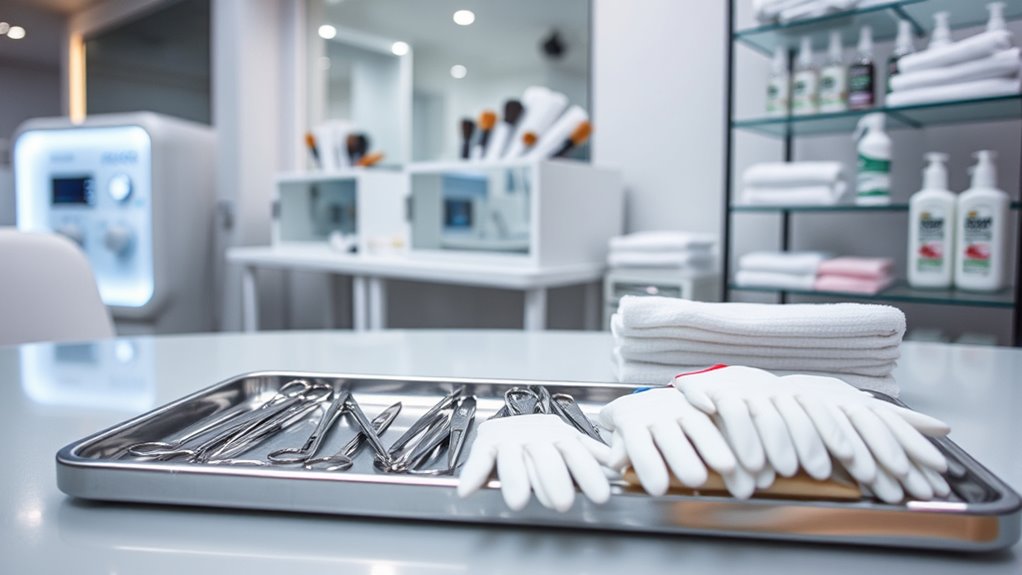To guarantee top salon cleanliness and sterilization, follow a clear checklist: wash your hands regularly and use gloves when needed. Sanitize all tools and work surfaces after each client, and sterilize metal instruments with autoclaves or disinfectants. Keep detailed records of cleaning schedules, train staff on proper hygiene practices, and perform routine audits. Prioritize continuous upkeep to prevent cross-contamination and maintain your reputation—stay with us to explore every expert tip.
Key Takeaways
- Establish and document strict hygiene protocols for handwashing, glove use, and surface sanitation.
- Regularly disinfect and sterilize all tools and equipment between clients, using approved methods.
- Maintain detailed records of sterilization procedures, schedules, and staff training to ensure compliance.
- Train staff consistently on proper cleaning, disinfection, and sterilization techniques.
- Conduct routine hygiene audits and inspections to uphold cleanliness standards and address any gaps immediately.

Have you ever wondered how clean and sterile your salon really is? Maintaining a hygienic environment isn’t just about appearances; it’s essential for client safety and your reputation. To achieve this, you need to strictly follow hygiene protocols and prioritize equipment sanitation. These practices aren’t just recommended—they’re mandatory for a professional, trustworthy salon.
Ensuring your salon’s cleanliness is vital for client safety and your professional reputation.
Hygiene protocols form the backbone of your salon’s cleanliness efforts. You should have clear, written procedures that everyone on your team understands and follows. This includes regular handwashing with soap and water or using alcohol-based hand sanitizers before and after each client. Wearing disposable gloves during treatments, especially those involving skin contact or open wounds, minimizes the risk of cross-contamination. You also need to sanitize workstations and tools frequently, ensuring no surface or item becomes a breeding ground for germs. Proper disposal of used supplies, like towels or disposable tools, must be enforced to prevent contamination. Implementing strict protocols for cleaning high-touch areas, such as door handles, light switches, and reception counters, helps keep your entire space hygienic.
Equally important is equipment sanitation. Every tool and device used during treatments should be thoroughly cleaned and disinfected between clients. Manual tools like scissors, nail files, and cuticle pushers require immediate cleaning after each use with soap and water, followed by disinfectant solutions approved for salon equipment. Electronic devices—like UV sterilizers, clippers, or tattoo machines—must be regularly serviced and sterilized according to manufacturer instructions. Using hospital-grade disinfectants can guarantee deep sanitation, but you need to be aware of the contact time needed for effective sterilization. Autoclaves, if available, are ideal for sterilizing metal tools, as they kill bacteria, viruses, and spores. Keep detailed records of sterilization procedures and schedules, so you can demonstrate compliance during inspections or client inquiries. Staff training is vital here; everyone must understand the importance of equipment sanitation and how to properly clean and disinfect tools. Incorporating high contrast ratio projectors into your salon environment, such as for entertainment or consultations, can further elevate the client experience by providing clear, vibrant visuals.
Consistency is key to maintaining high standards. Regular audits of your hygiene protocols and equipment sanitation practices reveal gaps and help you improve. Keeping your salon spotless isn’t a one-time effort—it’s an ongoing commitment. When your clients see that you prioritize their health with rigorous hygiene measures, they’ll trust your professionalism and keep coming back. In the end, proper hygiene protocols and diligent equipment sanitation aren’t just about following rules—they’re about safeguarding your clients and building a reputable, thriving salon.
Frequently Asked Questions
How Often Should Sterilization Equipment Be Calibrated?
You should calibrate sterilization equipment regularly to guarantee accuracy and safety. Most experts recommend following your calibration schedule, typically every six to twelve months, but it depends on usage and manufacturer guidelines. Regular calibration maintains equipment accuracy, prevents errors, and guarantees effective sterilization. Keep detailed records of each calibration to track performance and schedule timely recalibrations, ensuring your salon remains compliant and hygienic for every client.
What Are the Best Disinfectants for Different Salon Tools?
Think of your tools as warriors needing the right armor. You should use disinfectant efficacy and tool-specific disinfectants to make certain each tool is properly sanitized. For example, alcohol-based disinfectants work well on metal implements, while quaternary ammonium compounds suit plastic tools. Always choose disinfectants proven effective for your specific tools, and follow manufacturer instructions to keep your salon safe and spotless, like a well-oiled machine.
How to Train Staff on Sterilization Procedures Effectively?
You should implement hands-on staff training sessions focused on sterilization procedures, guaranteeing everyone understands proper techniques and safety protocols. Use clear demonstrations, provide written guidelines, and encourage questions to reinforce learning. Regularly review and update training, monitor compliance, and offer feedback. By actively engaging your team in sterilization procedures, you ensure consistent cleanliness standards, reduce cross-contamination risks, and maintain a safe, professional salon environment.
Are There Eco-Friendly Sterilization Options Available?
Yes, eco-friendly sterilization options are available. You can use biodegradable agents that break down naturally, reducing environmental impact. Reusable sterilization tools, like sterilization pouches and metal implements, also promote sustainability by minimizing waste. Incorporate these methods into your salon’s routine to maintain cleanliness while being eco-conscious. Switching to biodegradable agents and reusable tools helps you protect the environment without compromising sterilization standards.
How to Handle Sterilization Failures or Contamination Incidents?
When a sterilization failure or contamination occurs, act swiftly to protect clients and staff. For example, if tools are suspected of contamination, immediately isolate and discard them, then perform a thorough sterilization recheck. Your contamination response should include reviewing protocols, documenting the incident, and notifying clients if needed. Regular staff training helps prevent future issues, ensuring safety remains your top priority during sterilization failures.
Conclusion
Remember, a spotless salon isn’t just about shiny floors—it’s your secret weapon against unhappy clients and costly infections. Skip the sterilization, and you might as well hand out bacteria as parting gifts. So, keep your tools clean, your workspace sanitized, and your reputation intact. After all, nothing says “professional” like knowing your clients leave healthier than when they arrived—unless, of course, you enjoy the thrill of playing infection roulette. Stay safe, stay spotless!









